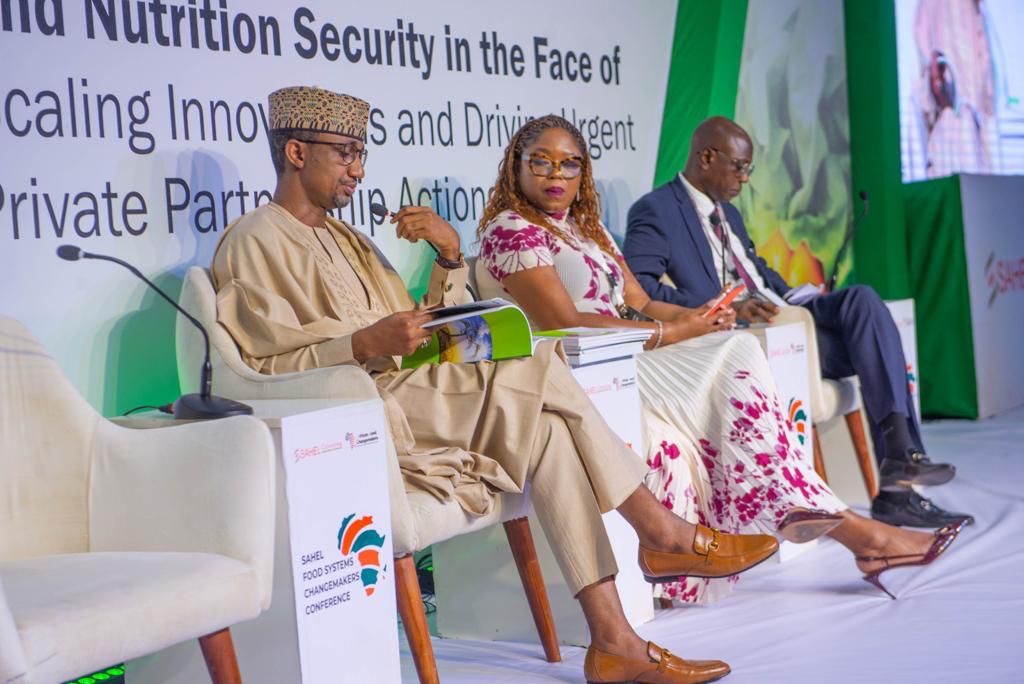Achieving sustainable food systems in Global crises paramount – Sahel Consulting | The Guardian Nigeria News – Nigeria and World News
Achieving sustainable food systems in Global crises paramount – Sahel Consulting Guardian Nigeria


Sustainable Agriculture and Rural Development Key to Ending Hunger in Nigeria

Sahel Consulting Agriculture and Nutrition Limited has emphasized the need for increased investment in sustainable agriculture and rural development in Nigeria to effectively address the issue of hunger.
Sahel Food Systems Changemakers Conference
The importance of sustainable agriculture and rural development was discussed extensively at the Sahel Food Systems Changemakers Conference in Abuja, organized by Sahel Consulting.
Challenges Faced by Nigeria
The Director General and CEO of NiMET, Prof. Mansur Matazu, and Dr Sanjo Faniran of UN Food System highlighted the unprecedented challenges faced by Nigeria. The country is experiencing irregular and increasingly harsh weather patterns, including unpredictable rains, extended droughts, and severe floods. These challenges disrupt the typical agricultural cycle, leading to crop failures and food insecurity. Farmers are left in a precarious position as they struggle to determine the optimal timing for sowing, irrigating, fertilizing, and harvesting their crops.
The impact of these challenges extends beyond crops to livestock productivity, disrupting the nation’s food supply chain and increasing the cost of food.
The Role of Nigerian Meteorological Agency (NiMET)
The Nigerian Meteorological Agency (NiMet), as one of the oldest public institutions in the country, plays a critical role in providing meteorological information to the government and citizens. NiMet generates and analyzes frequent weather and climate data, offering real-time weather and climate services to farmers, herders, and fishermen. Incorporating climate advisory into farming has been proven to increase yield by approximately 30% and reduce risk. Early warning advisory to smallholder farmers is crucial in mitigating climate change-induced disasters.
Current Limitations and Recommendations
Despite the existence of donor-funded programs that support the integration of weather and climate early warning advisory into smallholder farming operations, these initiatives are not at scale and are limited to specific project focus areas and priority value chains. The Agri-Extension package in Nigeria also does not include weather and climate advisory.
To address these limitations, the following recommendations were made:
- Integration of weather and climate advisory systems into the sub-national level, as current early warning efforts are concentrated at the federal level.
- Investment by state and local governments in efforts and partnerships to downscale seasonal climate prediction information to the district levels where it is most needed.
- Involvement of local actors to ensure ownership, resilience, and sustained adoption at the grassroots level.
- Collaboration with farmer and industry associations such as the All-Farmers Association of Nigeria and the Nigeria Agribusiness group to reach smallholder farmers at scale.
- Creation of strategic partnerships with the Nigerian Communications Commission (NCC) and telecommunication companies to support the creation of affordable and accessible information delivery systems through SMS and USSD codes.
- Establishment of a standardized alerting protocol for early warning that will provide smallholder rural farmers and SMEs with credible information.
Embracing Modern Weather Early Warning Systems
The challenges faced by the Nigerian food and agriculture sector due to climate change are undeniable. To ensure food security, maintain economic stability, and uplift millions of livelihoods, Nigeria must embrace modern weather early warning systems at all levels. With dedicated approaches and investments in these systems, the nation can provide farmers with the tools and information they need to navigate the uncertain climate future, securing a brighter agricultural landscape for all.
SDGs, Targets, and Indicators
-
SDG 2: Zero Hunger
- Target 2.3: By 2030, double the agricultural productivity and incomes of small-scale food producers, in particular women, indigenous peoples, family farmers, pastoralists, and fishers, including through secure and equal access to land, other productive resources and inputs, knowledge, financial services, markets, and opportunities for value addition and non-farm employment.
- Indicator 2.3.1: Volume of production per labor unit by classes of farming/pastoral/forestry enterprise size.
-
SDG 13: Climate Action
- Target 13.1: Strengthen resilience and adaptive capacity to climate-related hazards and natural disasters in all countries.
- Indicator 13.1.1: Number of deaths, missing persons, and directly affected persons attributed to disasters per 100,000 population.
- Indicator 13.1.2: Number of countries that adopt and implement national disaster risk reduction strategies in line with the Sendai Framework for Disaster Risk Reduction 2015-2030.
-
SDG 17: Partnerships for the Goals
- Target 17.6: Enhance North-South, South-South, and triangular regional and international cooperation on and access to science, technology, and innovation and enhance knowledge sharing on mutually agreed terms, including through improved coordination among existing mechanisms, particularly at the United Nations level, and through a global technology facilitation mechanism.
- Indicator 17.6.1: Number of science and/or technology cooperation agreements and programmes between countries, by type of cooperation.
Table: SDGs, Targets, and Indicators
| SDGs | Targets | Indicators |
|---|---|---|
| SDG 2: Zero Hunger | Target 2.3: By 2030, double the agricultural productivity and incomes of small-scale food producers, in particular women, indigenous peoples, family farmers, pastoralists, and fishers, including through secure and equal access to land, other productive resources and inputs, knowledge, financial services, markets, and opportunities for value addition and non-farm employment. | Indicator 2.3.1: Volume of production per labor unit by classes of farming/pastoral/forestry enterprise size. |
| SDG 13: Climate Action | Target 13.1: Strengthen resilience and adaptive capacity to climate-related hazards and natural disasters in all countries. | Indicator 13.1.1: Number of deaths, missing persons, and directly affected persons attributed to disasters per 100,000 population. Indicator 13.1.2: Number of countries that adopt and implement national disaster risk reduction strategies in line with the Sendai Framework for Disaster Risk Reduction 2015-2030. |
| SDG 17: Partnerships for the Goals | Target 17.6: Enhance North-South, South-South, and triangular regional and international cooperation on and access to science, technology, and innovation and enhance knowledge sharing on mutually agreed terms, including through improved coordination among existing mechanisms, particularly at the United Nations level, and through a global technology facilitation mechanism. | Indicator 17.6.1: Number of science and/or technology cooperation agreements and programmes between countries, by type of cooperation. |
Analysis
1. Which SDGs are addressed or connected to the issues highlighted in the article?
The SDGs addressed or connected to the issues highlighted in the article are SDG 2: Zero Hunger, SDG 13: Climate Action, and SDG 17: Partnerships for the Goals.
2. What specific targets under those SDGs can be identified based on the article’s content?
Based on the article’s content, the specific targets identified are:
– Target 2.3: By 2030, double the agricultural productivity and incomes of small-scale food producers.
– Target 13.1: Strengthen resilience and adaptive capacity to climate-related hazards and natural disasters in all countries.
– Target 17.6: Enhance North-South, South-South, and triangular regional and international cooperation on and access to science, technology, and innovation.
3. Are there any indicators mentioned or implied in the article that can be used to measure progress towards the identified targets?
Yes, there are indicators mentioned or implied in the article that can be used to measure progress towards the identified targets. The indicators mentioned are:
– Indicator 2.3.1: Volume of production per labor unit by classes of farming/pastoral/forestry enterprise size.
– Indicator 13.1.1: Number of deaths, missing persons, and directly affected persons attributed to disasters per 100,000 population.
– Indicator 13.1.2: Number of countries that adopt and implement national disaster risk reduction strategies in line with the Sendai Framework for Disaster Risk Reduction 2015-2030.
– Indicator 17.6.1: Number of science and/or technology cooperation agreements and programmes between countries, by type of cooperation.
These indicators can be used to measure progress towards the targets of increasing agricultural productivity and incomes, strengthening resilience to climate-related hazards, and enhancing cooperation on science, technology, and innovation.
4. Table: SDGs, Targets, and Indicators
| SDGs | Targets | Indicators |
|---|---|---|
| SDG 2: Zero Hunger | Target 2.3: By 2030, double the agricultural productivity and incomes of small-scale food producers, in particular women, indigenous peoples, family farmers, pastoralists, and fishers, including through secure and equal access to land, other productive resources and inputs, knowledge, financial services, markets, and opportunities for value addition and non-farm employment. | Indicator 2.3.1: Volume of production per labor unit by classes of farming/pastoral/forestry enterprise size. |
| SDG 13:
Behold! This splendid article springs forth from the wellspring of knowledge, shaped by a wondrous proprietary AI technology that delved into a vast ocean of data, illuminating the path towards the Sustainable Development Goals. Remember that all rights are reserved by SDG Investors LLC, empowering us to champion progress together. Source: guardian.ng
Join us, as fellow seekers of change, on a transformative journey at https://sdgtalks.ai/welcome, where you can become a member and actively contribute to shaping a brighter future.
|








